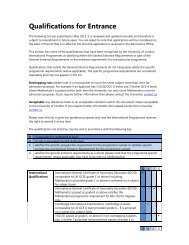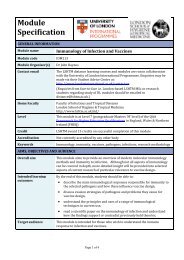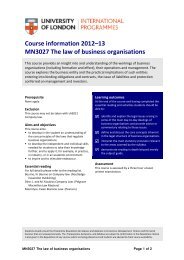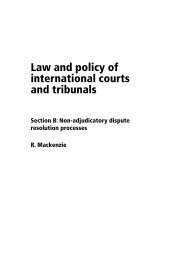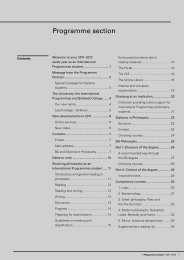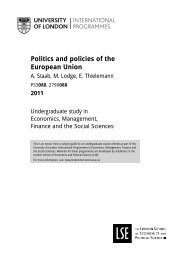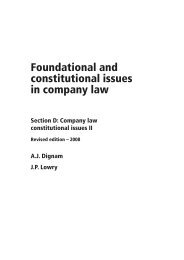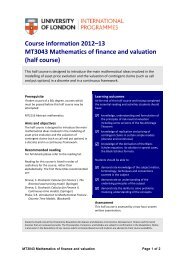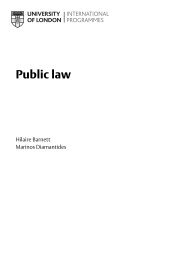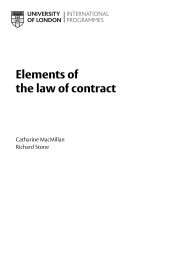Examiners' commentaries 2011
Examiners' commentaries 2011
Examiners' commentaries 2011
Create successful ePaper yourself
Turn your PDF publications into a flip-book with our unique Google optimized e-Paper software.
Examiners’ <strong>commentaries</strong> <strong>2011</strong><br />
92 Corporate finance – Zone B<br />
Important note<br />
This commentary reflects the examination and assessment arrangements<br />
for this course in the academic year 2010–11. The format and structure<br />
of the examination may change in future years, and any such changes<br />
will be publicised on the virtual learning environment (VLE).<br />
Format of the examination paper<br />
Candidates should answer FOUR of the following EIGHT<br />
questions: ONE from Section A, ONE from Section B and TWO<br />
further questions from either section. All questions carry equal<br />
marks.<br />
A list of formulas, extracts from Present Value and Annuity Discount<br />
tables, are given at the end of the paper.<br />
A calculator may be used when answering questions on this paper<br />
and it must comply in all respects with the specification given with<br />
your Admission Notice. The make and type of machine must be<br />
clearly stated on the front cover of the answer book.<br />
Comments on specific questions<br />
Answer one question from this section and not more than a further<br />
two questions. (You are reminded that four questions in total are to be<br />
attempted with at least one from Section B.)<br />
Section A<br />
Question 1<br />
a. Derive the Capital Asset Pricing Model (CAPM).<br />
Reading for the question<br />
Subject guide, pp.34–35.<br />
Approaching the question<br />
(10 marks)<br />
This question focuses on the derivation of CAPM. Students should refer to<br />
the mathematical derivation in the subject guide.<br />
Suppose an investor holds a portfolio which combines a% of an asset i and<br />
(1-a)% of the market portfolio. The expected return and variance of the<br />
portfolio p are:<br />
E ( Rpt)<br />
= aE ( Rit)<br />
+ ( 1 − a ) E ( Rmt)<br />
(1.1)<br />
and<br />
( ) [ ( ) ( ) ] 2 / 1<br />
2 2<br />
2 2<br />
σ Rpt = a σ i + 1–<br />
a σ m + 2a 1 – a σim<br />
(1.2)<br />
where is the variance of the return on a risky asset i; 2 is the variance<br />
i m<br />
of the return on the market portfolio; and is the covariance of returns<br />
im<br />
between asset i and the market portfolio. The marginal rate of substitution<br />
(MRS) between the expected return and risk of the market portfolio is<br />
Examiners’ <strong>commentaries</strong> <strong>2011</strong><br />
1
92 Corporate finance<br />
2<br />
defined as the ratio of the partial differentiation of its expected return over<br />
the partial differentiation of its expected risk of the portfolio with respect to<br />
a. In equilibrium, all marketable assets are included in the market portfolio<br />
and there is no excess demand or supply for any individual asset. This<br />
implies that<br />
∂ E ( R ) / ∂a<br />
pt E(<br />
R ) – E ( R )<br />
(1.3)<br />
it<br />
mt<br />
=<br />
2<br />
∂E<br />
( σ ) / ∂a<br />
( σ – σ ) / σ<br />
pt<br />
im m m<br />
a = 0<br />
Also note that the MRS at the market portfolio is the same as the slope<br />
of the capital market line (CML) at the point of tangency to the efficient<br />
frontier. It can be shown that<br />
E ( R ) E ( R ) E ( R ) E(<br />
R )<br />
MRS =<br />
it − mt<br />
it − mt<br />
=<br />
2<br />
( σ − σ ) σ<br />
σ<br />
im<br />
m<br />
Rearranging the equation (1.4), we have<br />
E( R ) = R + β E ( R ) − R<br />
it<br />
ft<br />
i<br />
m<br />
[ ]<br />
mt<br />
ft<br />
m<br />
= Slope of the CML<br />
(1.4)<br />
(1.5)<br />
where = / . Equation (1.5) shows that there is an exact linear<br />
i im m<br />
relationship between an asset’s return and its beta.<br />
Students may approach this question differently from the suggested<br />
guide here. An alternative approach is to discuss how the portfolio<br />
theory, two fund separation theorem and other related theories may<br />
lead to the CAPM.<br />
b. ‘The CAPM is untestable.’ How far do you agree and disagree with this<br />
statement? Critically evaluate this statement. (15 marks)<br />
Reading for the question<br />
Subject guide, pp.37–39; BMA, Chapter 8, pp.223–27.<br />
Approaching the question<br />
The key points are:<br />
i. The validity of CAPM depends on whether the market portfolio is<br />
mean-variance efficient.<br />
ii. But the true market portfolio is not observable.<br />
iii. Proxies for the market portfolio are often taken from broad-based<br />
equity indices which do not contain all the tradable securities or<br />
non-financial assets such as real estates, durable goods and even<br />
human capital.<br />
iv. This renders CAPM untestable.<br />
A good answer should cover the above points with emphasis on<br />
the emboldened words or phrases. As this question specifically asks<br />
students to evaluate the statement critically, high marks would only<br />
be given if such critical analysis is provided in the answer.
Question 2<br />
a. Explain clearly how an efficient takeover may occur. (15 marks)<br />
Reading for the question<br />
Subject guide, pp.140–41.<br />
Approaching the question<br />
It should be noted that this question asks for the second part of Grossman<br />
and Hart (1980). Some students discuss the impossibility of an efficient<br />
takeover instead. Many students regurgitate the materials from the subject<br />
guide.<br />
Some key points worth noting are:<br />
i. The free-rising problem can be solved by the dilution effect.<br />
a. The raider can extract the value from the target if the takeover is<br />
completed.<br />
b. As long as the value that can be extracted by the raider exceeds<br />
the cost of the acquisition, shareholders are willing to tender their<br />
shares for the takeover (as free-riding is no long optional to them)<br />
ii. Existence of large shareholders may facilitate a takeover.<br />
a. Shareholders will tender their shares if p > z (where p is the<br />
premium paid by the raider and z is the value improvement after<br />
the takeover)<br />
b. Large shareholders will tender their shares if z > (1-a)p + c where<br />
a is the proportion of shares held by the large shareholders and c is<br />
the cost of acquisition.<br />
c. To satisfy both conditions a and b, az > c. So large shareholders will<br />
ensure the success of a takeover if the value improvement accrued<br />
to their shareholders exceeds the cost of acquisition.<br />
b. Outline the arguments for the agency cost on equity. Explain how the use of<br />
short term bonds might mitigate the agency conflict between equity-holders<br />
and debt-holders in financially distressed firms with high debt to equity<br />
ratios. (10 marks)<br />
Reading for the question<br />
Subject guide, pp.112–15.<br />
Approaching the question<br />
This question centres on the agency cost of outside equity. It should<br />
be explained clearly including the following key points:<br />
i. Consider the rewards and costs facing a manager/equity-holder.<br />
ii. More equity held by outsiders, less effort spent by the managers/<br />
equity-holder.<br />
iii. Issuing debt to replace the outside equity will then increase the<br />
leverage and the % of outstanding equity held by manager/equityholder.<br />
As his/her share of the residual value of the firm increases,<br />
he/she will choose to supply more effort, leading to increased firm<br />
value.<br />
iv. Conflicts between shareholders and debt-holders:<br />
a. The problem of asset substitution and risk shifting may arise.<br />
b. Using short-term debt gives debt-holders an early opportunity to<br />
review the firm’s managerial effect.<br />
Examiners’ <strong>commentaries</strong> <strong>2011</strong><br />
3
92 Corporate finance<br />
4<br />
c. Managers may need to supply their effort to maximise the firm’s<br />
value and look after both the equity and debt-holders at the same<br />
time. Arguably reducing the possible conflicts between the two<br />
different types of stakeholders.<br />
Many candidates regurgitated the materials from the subject guide and<br />
some provided answers on the agency cost on debt instead.<br />
Question 3<br />
a. Explain clearly the 3 main conditions for dividends to work effectively as a<br />
signal of a firm’s value. (9 marks)<br />
Reading for the question<br />
Subject guide, pp.132 and 119–120.<br />
Approaching the question<br />
This question tests students’ ability to understand how the Ross (1977)<br />
model may be used to analyse the signalling effect of dividends. We are<br />
not expecting candidates to develop a set of equations such as those<br />
included on pp.119 and 120 of the subject guide. Instead the focus<br />
should be on the necessary conditions which enable dividends to act as an<br />
efficient signal.<br />
The three key conditions are:<br />
i. The market is adhering to the semi-strong form efficiency but not<br />
strong form. A firm’s true value is therefore not observable.<br />
ii. Managers (according to Lintner’s stylised fact) would not change<br />
dividend unless it is sustainable in the future.<br />
iii. Therefore good quality firm will pay high dividend to signal its<br />
strength and commitment.<br />
b. Critically assess the empirical evidence for the weak form market efficiency.<br />
(10 marks)<br />
Reading for the question<br />
Subject guide, pp.64–68.<br />
Approaching the question<br />
Candidates should discuss how the weak form efficiency is tested in<br />
empirical studies and in particular, focus on the implications of the<br />
findings from the random walk tests, return autocorrelation tests, calendar<br />
effects and trading rules.<br />
c. Explain why Net Present Value is a better investment appraisal technique<br />
than Internal Rate of Return. (6 marks)<br />
Reading for the question<br />
Subject guide, pp.18 and 19; BMA, Chapter 5, pp.137–43.<br />
This part was generally quite well answered. The key points that should<br />
be discussed are:<br />
i. IRR does not account for the size and magnitude of the project. It is<br />
not a good tool to rank projects.<br />
ii. Costs of capital may vary over time but the IRR assumes that any spare<br />
cash can be re-invested at the same rate.<br />
iii. IRR is not additive and therefore the total IRR of all projects needs<br />
to be re-computed. NPV has an additive property and therefore the<br />
combined effect can be determined easily.
Question 4<br />
a. Explain Modigliani and Miller’s argument on the irrelevancy of debt and<br />
dividend policies. (10 marks)<br />
Reading for the question<br />
Subject guide, pp.91–93 and 128.<br />
Approaching the question<br />
Candidates should place equal importance to the two parts of this question.<br />
Many candidates simply focus on the irrelevance of capital structure and<br />
ignore dividend policy.<br />
First, we should note that the combined cash return to all stakeholders<br />
is the same regardless of the firm’s capital structure. This can be easily<br />
illustrated in a simple example such as Table 6.1 on p.92 of the subject<br />
guide.<br />
Second, regarding the irrelevancy of dividend policies, candidates should<br />
point out that in the world with no tax, shareholders are indifferent<br />
between capital gain and dividend income. They can replicate any dividend<br />
policy through appropriate purchases and sales of shares.<br />
b. Using the arguments for the signalling and tax effects of debts, to what extent<br />
would you conclude that debt policy is relevant to corporate value?<br />
(15 marks)<br />
Reading for the question<br />
Subject guide, pp.94–97 and 119–120.<br />
Approaching the question<br />
There are two parts in this question. To deal with the tax effect of debt,<br />
candidates should discuss the following key points:<br />
• Interest on debt is tax deductible and therefore creates a tax shield<br />
effect.<br />
• The higher the debt, the more interest is paid and hence the higher the<br />
tax shield benefits.<br />
• The firm’s value increases as a result of the higher level of debt.<br />
• However, more debt will increase the potential cost of financial distress.<br />
The value of the firm may not increase as much as the absolute tax<br />
shield.<br />
The second part requires candidates to discuss the main conditions<br />
for debt to work as an effective signal. You should explain why the<br />
following three conditions need to be met and what implications they<br />
have in terms of debt policy:<br />
• Market – must be adhering to the semi-strong (but not strong form<br />
otherwise the firm’s value can be observed).<br />
• Good firms with optimistic future cash flows can afford to issue more<br />
debt and pay more interest. Therefore those firms with high levels of<br />
debt signal their strength and their value will be improved.<br />
• The penalty of using incorrect signals is more costly than the short<br />
term gain.<br />
Examiners’ <strong>commentaries</strong> <strong>2011</strong><br />
5
92 Corporate finance<br />
6<br />
Section B<br />
Answer one question from this section and not more than a further<br />
two questions. (You are reminded that four questions in total are to be<br />
attempted with at least one from Section A.)<br />
Question 5<br />
a. Leopard plc is considering purchasing a new machine in its manufacturing<br />
plant. The machine is required on a going concern basis. The company has the<br />
following two options:<br />
Machines Year 0 Year 1 Year 2 Year 3 Year 4<br />
A –100,000 90,000 80,000 50,000<br />
B –150,000 35,000 45,000 55,000 65,000<br />
All figures are quoted in $. The cost of capital for Leopard plc is 10% per<br />
annum. In which machine should Leopard plc invest?<br />
Reading for the question<br />
BMA, Chapter 6, pp.169–73.<br />
Approaching the question<br />
(6 marks)<br />
Machine A<br />
Year CF’s DF PV AEV<br />
0 –100 1 –100<br />
1 90 0.909 81.81<br />
2 80 0.826 66.08<br />
3 50 0.751 37.55<br />
2.486 85.44 34.368<br />
Machine B<br />
Year CF’s DF PV AEV<br />
0 –150 1 –150<br />
1 35 0.909 31.815<br />
2 45 0.826 37.17<br />
3 55 0.751 41.305<br />
4 65 0.683 44.395<br />
3.169 4.685 1.478<br />
Given that Machine A has the higher NPV and AEV (annual equivalent<br />
value), we should invest in it.<br />
b. GQ Ltd has been presented with the following project:<br />
A new machine for $250,000 is required at the beginning of the first year. The<br />
machine will last for 4 years and thereafter can be disposed of for $25,000.<br />
The company’s policy is to depreciate this type of machine over its economic<br />
life on a straight-line basis.<br />
The demand for the product MH depends on the future states of the<br />
economy. In the good state, GQ Ltd expects to sell 15,000 units per year for<br />
the next 4 years. If the economy is bad, sales will fall to 5,000 units per year.<br />
Each state of the economy has an equal probability to materialise. Each unit<br />
of product MH will be priced at $40. Total variable costs are expected to be<br />
$30 per unit in the first year and thereafter rise at 10% per year.<br />
[For the full question, please refer to the Examination paper.]
Reading for the question<br />
BMA Chapter 6, pp.156–69.<br />
Approaching the question<br />
Examiners’ <strong>commentaries</strong> <strong>2011</strong><br />
0 1<br />
Year<br />
2 3 4<br />
Machine (250,000) 25,000<br />
Revenue 400,000 400,000 400,000 400,000<br />
Costs (300,000) (330,000) (363,000) (399,300)<br />
NCF before tax (250,000) 100,000 70,000 37,000 25,700<br />
Tax (11,250) (6,938) (553) 23,931<br />
NCF after tax (250,000) 88,750 63,063 36,447 49,631<br />
DF 1 0.909 0.826 0.751 0.683<br />
PV (250,000) 80,674 52,090 27,372 33,898<br />
NPV (55,967)<br />
NCF = Taxable profit 100,000 70,000 37,000 25,700<br />
Capital allowances (62,500) (46,875) (35,156) (105,469)<br />
Taxable profit after CA 37,500 23,125 1,844 (79,769)<br />
Tax 11,250 6,938 553 (23,931)<br />
i. Given that the NPV of the project is negative, it is not advisable to<br />
invest in it.<br />
Would we accept this project if the cost of capital is reduced? To<br />
answer this question, we recomputed the NPV using a lower discount<br />
rate. For illustration purposes, we use 5% as a new reduced cost of<br />
capital. The NPV of the project can be recomputed as follows:<br />
NCF after tax (250,000) 88,750 63,063 36,447 49,631<br />
DF (5%) 1 0.952 0.907 0.864 0.823<br />
PV (250,000) 84,490 57,198 31,490 40,846<br />
NPV (35,976)<br />
IRR = 5% – 35,976/(–35976 + 55967) × 5% = –4%<br />
ii. The cost of capital needs to drop by 14% to wipe out the NPV entirely.<br />
This implies that this project will never break even.<br />
Question 6<br />
a. The last 5 years returns on Fly-away plc and Stay-at-home plc are as follows:<br />
Year Fly-away, % Stay-at-home, %<br />
2010 0 14<br />
2009 –4 –2<br />
2008 8 0<br />
2007 10 –5<br />
2006 6 18<br />
Calculate the return and risk of a portfolio which consists of 50% Fly-away<br />
and 50% Stay-at-home.<br />
Reading for the question<br />
(10 marks)<br />
BMA, Chapter 7, pp.202–05 (especially Table 7.7).<br />
7
92 Corporate finance<br />
8<br />
Approaching the question<br />
I II III IV IV VI VII<br />
Year Fly-away, % Stay-athome,<br />
%<br />
I - mean II - mean III x III IV x IV III x IV<br />
2010 0 14 –4 9 16 81 –36<br />
2009 –4 –2 –8 –7 64 49 56<br />
2008 8 0 4 –5 16 25 –20<br />
2007 10 –5 6 –10 36 100 –60<br />
2006 6 18 2 13 4 169 26<br />
Sum 20 25 136 424 –34<br />
Mean 4 5<br />
Variance 34 106<br />
Covariance –8.5<br />
Stdev 5.83 10.30<br />
Portfolio variance = 0.5 0.5 34 + 0.5 0.5 106 0.5 0.5 –8.5 = 30.75<br />
Portfolio risk = square root of the variance = 5.55<br />
Note that the above figures are adjusted for the small sample error.<br />
b. Suppose the returns on Stock x, y and z are determined by the following twofactor<br />
model:<br />
r<br />
r<br />
r<br />
x<br />
y<br />
z<br />
=<br />
=<br />
=<br />
0.<br />
2<br />
0.<br />
16<br />
0.<br />
5<br />
+ 2 F − F<br />
1<br />
1<br />
+ 1.<br />
2 F<br />
1<br />
+ F + F<br />
2<br />
2<br />
+<br />
=<br />
= 10%<br />
0.<br />
5<br />
F<br />
6%<br />
2<br />
=<br />
8%<br />
i. Determine the portfolio weights you need to place on x, y and z in order<br />
to replicate the portfolio returns on F and F respectively. 1 2 (10 marks)<br />
ii. The return on Stock M is known to follow the following factor model<br />
r = 0.2 + 1.6F + 1.8F m 1 2<br />
It is currently traded with a return of 10%. Explain if any arbitrage<br />
opportunity arises in this case.<br />
Reading for the question<br />
Subject guide, pp.46–50.<br />
Approaching the question<br />
(5 marks)<br />
Let x, y and z as the weight in X, Y and Z.<br />
For<br />
( 1)<br />
( 2)<br />
( 3)<br />
( 2)<br />
( 2)<br />
F<br />
1<br />
x + y + z = 1<br />
2 x +<br />
− x +<br />
−<br />
−<br />
( 1)<br />
( 3)<br />
1.<br />
2<br />
⇒ y = 10<br />
⇒ z = −7<br />
0.<br />
5<br />
⇒ x = −2<br />
y + z = 1<br />
y + z = 0<br />
⇒ x + 0.<br />
2 y = 0<br />
⇒ 3 x +<br />
0.<br />
7<br />
y = 1
For F2<br />
( 1)<br />
( 2)<br />
( 3)<br />
( 2)<br />
( 2)<br />
x + y + z = 1<br />
2 x +<br />
− x +<br />
−<br />
−<br />
( 1)<br />
( 3)<br />
1.<br />
2<br />
⇒ y = 20<br />
0.<br />
5<br />
⇒ x = −5<br />
⇒ z = −14<br />
y + z = 0<br />
y + z = 1<br />
⇒ x + 0.<br />
2 y = −1<br />
⇒ 3 x + 0.<br />
7y<br />
= −1<br />
The expected returns on x, y and z are given in the question as 10%, 8%<br />
and 6% respectively. Therefore the expected return on:<br />
F1 = –2 10% + 10 8% – 7 6% = 18<br />
F2 = -5 20% + 20 16% – 14 5% = 26<br />
Expected return on M = 0.2 + 1.6 F1 1.8 F2 = 75.8.<br />
The expected return is higher than the observed return. It seems to<br />
suggest that M is overpriced and an arbitrage opportunity exists.<br />
Consequently, we can sell M and buy the replicated portfolio using F1 and<br />
F2.<br />
However, the return figures are grossly inconsistent with the factor model,<br />
it might suggest that the multi-factor model is not a correct pricing<br />
equation. Therefore the expected return cannot be estimated correctly. It<br />
is therefore hard to determine if arbitrage exists.<br />
Question 7<br />
Red Apple plc, a quoted company in Hong Kong, is considering to takeover<br />
Green Papaya Ltd. Both companies are 100% equity financed. The following<br />
information is available for these two companies:<br />
Red Apple Green Papaya<br />
Number of shares 100,000,000 2,000,000<br />
Share price £10 Not available<br />
Dividend per share (latest) $1 $0.8<br />
You discover the following additional information:<br />
i. Green Papaya Ltd. has been paying dividends at a constant growth rate of<br />
5% per annum for the last 5 years to its shareholders.<br />
ii. The Directors of Green Papaya have been using a discount rate of 10% per<br />
annum to appraise its projects.<br />
iii. It is believed that the cost of capital for Green Papaya will reduce to<br />
8% per annum once it is taken over by Red Apple.<br />
[For the full question, please refer to the Examination paper.]<br />
Reading for the question<br />
BMA, Chapter 31, pp.829–33.<br />
Examiners’ <strong>commentaries</strong> <strong>2011</strong><br />
9
92 Corporate finance<br />
10<br />
Approaching the question<br />
Part A<br />
Suppose Green Papaya’s dividend grows at 5% p.a. in the foreseeable<br />
future before the takeover.<br />
Share price, S = $0.8(1.05)/0.1 – 0.05 = $16.80<br />
Value, V = $16.80 2,000,000 = $33,600,000<br />
Part B<br />
New share price after the merger, S = 0.8 1.05 /(0.08 – 0.1) = $28.00<br />
New value after the merger, V = $28 2,000,000 = $56,000,000<br />
Part C<br />
Equity issue, raising cash<br />
Cost of acquisition = $8 5m = $40,000,000<br />
Net cost = 40,000,000 – 33,600,000 = $6,400,000<br />
Gain = $56,000,000 – $33,600,000 = $22,400,000<br />
Net gain = $22,400,000 – $6,400,000 = $16,000,000<br />
Share exchange<br />
Value of the combined company = $1,000,000,000 + $56,000,000 =<br />
$1,056,000,000<br />
New share price = $1,056m/104m = $10.15<br />
Cost of acquisition = $10.15 4m = $40,615,385<br />
Net cost = $40,615,385 – $33,600,000 = $7,015,385<br />
Gain =$56,000,000 – $33,600,000 = $22,400,000 (same as in the cash<br />
offer)<br />
Net gain = $22,400,000 – $7,015,385 = $15,384,615<br />
The advantages and disadvantages of cash and share exchange in M&A<br />
can be summarised as follows:<br />
Cash Acquired Acquiring<br />
Advantages Shareholders will receive a Acquiring firm’s shareholders<br />
certain cash flow when they sell will have full control over the<br />
their shares to the acquiring combined operation.<br />
firm. It implies that they will<br />
obtain a certain return on their<br />
investment.<br />
Disadvantages The receipt of cash is deemed<br />
to a disposal of shares which<br />
will attract capital gains tax<br />
and shareholders will lose<br />
ownership.<br />
Share exchange<br />
Advantages The acquired firm’s shareholders<br />
will maintain some form of<br />
ownership in the combined<br />
operation.<br />
Disadvantages The return on investment from<br />
the combined operation might<br />
be uncertain.<br />
There is a liquidity implication.<br />
Acquiring firm needs to raise<br />
sufficient cash flows for the<br />
acquisition.<br />
There is no cash outflow in this<br />
type of acquisition.<br />
Acquired firm’s shareholders<br />
need to share ownership with<br />
the shareholders from the<br />
acquiring firm.
Question 8<br />
a. Orchard plc’s share price, S, can either go up to S or down to S in the next<br />
H L<br />
period. Derive the price of a put option written on S in terms of a position in<br />
the stock and a risk free asset. (7 marks)<br />
b. Orchard plc’s shares are currently traded at $20 each. Its share price will<br />
go up to $22 or down to $17 in three months’ time. The effective interest<br />
rate for the next three months is 3%. What is the price of a put option on<br />
Orchard’s share with an exercise price of $20.5? (5 marks)<br />
c. Explain clearly why the price of a put option does not depend on the<br />
investor’s risk preference and the probabilities of the future states of the<br />
economy. Determine the risk neutral probabilities of the two states of the<br />
economy in (b). (13 marks)<br />
Reading for the question<br />
Subject guide, pp.60–63.<br />
Approaching the question<br />
a. Derive the option price<br />
Form a portfolio with a% in S and b in risk-free asset. This portfolio<br />
mimicks the payoff of a put option:<br />
P = aP + b(1 + r )<br />
H H f<br />
P = aP + b(1 + r )<br />
L L f<br />
Solving the two equations we have:<br />
a = P – P / S – S H L H L<br />
b = S P – S P / (1 + r )(S – S )<br />
L H H L f L H<br />
The value of a put, P = aS + b<br />
b. Given the information in the question, we can determine that:<br />
P = 0 H<br />
P = 3.5 L<br />
S = 22 H<br />
S = 17 L<br />
Substituting into the two equations in (a) we have:<br />
a = (0 – 3.5)/(22 – 17) = –3.5/5 = –0.7<br />
b = (17 0 – 22 3.5) / (1.03 –5) = 14.951<br />
The value of the put, P = –0.6 20 + 14.951 = 0.9515<br />
c. If S = uS (u percentage of S) and S = dS (d percentage of S), then<br />
H L<br />
a = (P – P )/(u – d)S<br />
H L<br />
b = (uP – dP )/(u – d)R<br />
L H<br />
and<br />
P = aS + b<br />
= (P – P )/(u – d)+ (uP – dP )/(u – d)R<br />
H L L H<br />
= [qP + (1 – q)P ]/R where q=(R – d)/(u – d), the risk neutral probability<br />
H L<br />
Using the information in (b), R = 1.03; d = 0.85; u = 1.1<br />
q = 1.03 – 0.85 / 1.1 – 0.85 = 0.72<br />
Information about the probability and risk are already priced in the<br />
underlying asset. Therefore the option prices which derived their values<br />
from the underlying asset will reflect these two pieces of information.<br />
Examiners’ <strong>commentaries</strong> <strong>2011</strong><br />
11
92 Corporate finance<br />
12<br />
To see this, we can express the current stock price as the probability<br />
weighted average of future prices of the two states:<br />
S = qSH – (1 – q)SL / 1 + rf<br />
q = R – d / u – d




